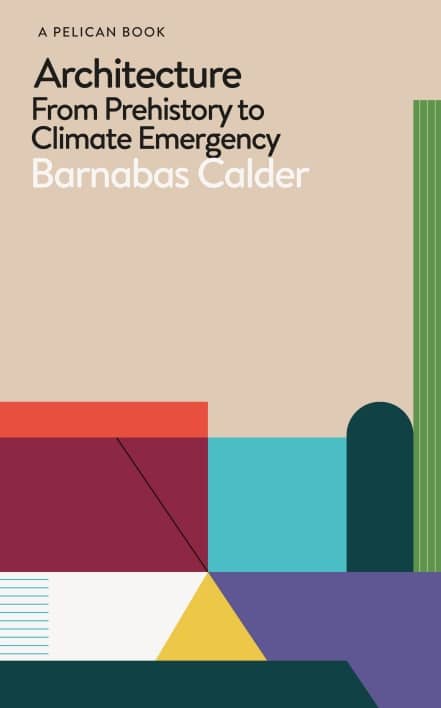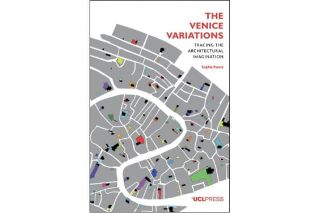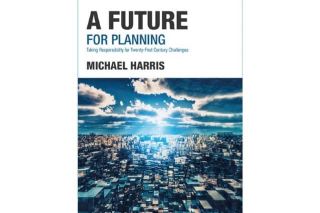
www.buildingsandcities.org/insights/reviews/calder.html
Architecture: From Prehistory to Climate Emergency
By Barnabas Calder. Pelican, 2021, ISBN: 9780241396735
Jeremy Till (Central Saint Martins) reviews this new history of architecture exploring how buildings have been shaped by the changing contexts of available energy.

The ambition of this book is announced on the spine which boldly states the title of the book: Architecture. Not Architecture and Energy, not Architecture and Climate, just plain Architecture, thereby introducing the big claim that the primary influence in architecture's constitution is energy. That Calder largely fulfils this claim is down to a truly astonishing depth and breadth of research, as well as his commitment to relating architecture to something beyond itself, namely the urgency of the climate emergency.
As a reader, I often start reading books by delving into their indexes because, like the ingredients in a recipe, they give a flavour of the finished article. The indexes of received histories of architecture reveal lists of architects and buildings, constructing a self-perpetuating canon of architecture. If there is any variation, it is like that in the DNA tests within a family - a few more Scandinavian traces in Richard Weston's writing, more Russian in Kenneth Frampton's works, smatterings of American in William Curtis' outputs. The overriding impression from most architectural histories is of a world unto itself, a set of batons being passed down an established line of styles and Western male heroes. By contrast, the index of Calder's brilliant book immediately establishes a very different context for architecture: the references for coal exceed those on Le Corbusier. Architecture is here insistently located in relation to the external forces of energy rather than to an internalised discourse.
The extraordinary range of sources in this book - including anthropology, economics, climate studies, construction history, material science - means that on almost every page even the most knowledgeable reader will find some new insight or fact. Calder does not use this range to dazzle the reader in a show-off manner, but to inform us within an accessible and compelling narrative. This is, after all, the Pelican book of Architecture, aimed at a broad audience but also here also satisfying a specialist one. The narrative is very convincing. For example, the standard histories struggle with the Le Corbusier's juxtaposition in his book, Vers une architecture, of the Parthenon, motor cars and electrical turbines, describing them in solely aesthetic terms of perfection of form and engineering. Calder's identification of Le Corbusier being "mesmerised by the new energy technologies" rings truer.
The argument through the book is that the state of energy supply is the main determinant for how our buildings and cities are conceived, constructed and occupied. The energy supply influences and shapes the economic and social structures involved in the creation and use of the built environment. Thus medieval London, with a relatively restricted hinterland of food production and reliant on timber as its main source of fuel, was a "city of wood, straw, thatch and animal dung." With the arrival of cheap (and dirty) coal in the 16th and 17th centuries it was transformed into a city of fired clay (brick) and molten sand (glass), and at the same time it became a city cloaked in soot and foul air. With the expanded extraction of cleaner coal in the 19th century, the mass production of pig iron was made possible, and this gave rise to new forms of structure. To produce iron with using wood as a fuel would have taken an area of woodland almost the size of England (one of those astonishing facts the book is full of).
The primary energy source covered in the early chapters is that of food for the construction workers, with the burning of wood being used only very judiciously. Thus 76% of the material in the Baths of Caracalla in ancient Rome did not require heat to be produced: lime, fired bricks and other fuelled materials were only used where absolutely necessary structurally or aesthetically. When the food supply to Rome collapsed with the fall of the Roman Empire, so did the development of the city. The narrative of the book accelerates in the second half of the book as prodigious supplies of fossil fuels allow buildings to take on completely new forms and structures, particularly when they are converted to electricity. The book captures the frenzy of production, first in Liverpool and then in the US, where elevators, steel, concrete, glass, and other carbon-hungry materials and processes redescribe the modern era as one in which "form follows fuel."
One can sense the tragedy of carbon emissions unfolding as the symbolic and technical hubris of the modern project led to an insatiable reliance on fossil fuels. The foreground effects of transparency and progress in Gropius' Bauhaus building in Dessau were only made possible (as another energy historian, Daniel Barber, has uncovered) by the background of three men permanently stoking the coal-fired boilers in a futile attempt to maintain temperatures as heat fled through the full-height single glazed windows. The International Style as a global phenomenon is tied to the idea that "the energy-hungry technologies were a great unifier," dismissive of local environmental or cultural conditions. With expanded and cheaper sources of energy, floorplates could be deepened, facades sealed, materials shipped around the globe, and the built world became detached from the natural world. By the time any idea of energy efficiency arrives at the end of the 20th century, the cause is already lost: our contemporary architecture is addicted to extraction, both in terms of energy in and energy out.
The only potential restriction of the book is that, as Calder himself notes, it concentrates on the canon of Eurocentric architectural history. This is probably in order to fulfil the publisher's brief in providing an overall introduction to architecture, and it certainly allows Calder to disrupt the normalising trajectories of previous architectural history. However, it also tends to exclude the other histories of architecture, of the everyday, of the Global South and of the vernacular. Their approaches to energy often provide better pointers as to how to extricate ourselves from the predicament of over-dependencies on energy that we find ourselves in.
The book ends with a homily to Matthew Barnett Howland's Cork House in Eton, UK. Tellingly the description of the Cork House is one of the few moments when Calder reverts to the language of form, light, beauty and phenomenological wonder - a distraction from the argument of the rest of the book. This is not to downplay the research and serious intent of the Cork House, but rather to note that we are not going to be able to confront the depth of the emergency with cork and strawbales alone. The climate emergency and the overconsumption of resources will demand systemic change. Interestingly the early chapters of the book in particular provide clear clues as to how this change might be achieved. These chapters concentrate on energy systems that go into the making of architecture. Current obsessions in sustainable architecture with reducing energy flows out of buildings are of course necessary, but much more critical is to look what energy goes into the production of buildings, cities and infrastructure, and the way carbon is embodied.
By tying architecture so clearly into the broad economic and social systems, by showing so convincingly how architecture depends, the book allows us to speculate how these systems, and their spatial formations, must be rethought in the future if we are to survive on this ravaged planet. It is a measure of the achievement of Calder's essential work that these issues are opened up in a manner that is at the same time accessible to a wide audience and rigorous. The real significance of the book is that it develops a new frame for architectural writing which frankly makes some of the previous architectural histories look at best parochial, or at worst irrelevant in the face of the global climate crisis.
Latest Peer-Reviewed Journal Content
Youth engagement in urban living labs: tools, methods and pedagogies
N Charalambous, C Panayi, C Mady, T Augustinčić & D Berc
Co-creating urban transformation: a stakeholder analysis for Germany’s heat transition
P Heger, C Bieber, M Hendawy & A Shooshtari
Placemaking living lab: creating resilient social and spatial infrastructures
M Dodd, N Madabhushi & R Lees
Church pipe organs: historical tuning records as indoor environmental evidence
B Bingley, A Knight & Y Xing
A framework for 1.5°C-aligned GHG budgets in architecture
G Betti, I Spaar, D Bachmann, A Jerosch-Herold, E Kühner, R Yang, K Avhad & S Sinning
Net zero retrofit of the building stock [editorial]
D Godoy-Shimizu & P Steadman
Co-learning in living labs: nurturing civic agency and resilience
A Belfield
The importance of multi-roles and code-switching in living labs
H Noller & A Tarik
Researchers’ shifting roles in living labs for knowledge co-production
C-C Dobre & G Faldi
Increasing civic resilience in urban living labs: city authorities’ roles
E Alatalo, M Laine & M Kyrönviita
Co-curation as civic practice in community engagement
Z Li, M Sunikka-Blank, R Purohit & F Samuel
Preserving buildings: emission reductions from circular economy strategies in Austria
N Alaux, V Kulmer, J Vogel & A Passer
Urban living labs: relationality between institutions and local circularity
P Palo, M Adelfio, J Lundin & E Brandão
Living labs: epistemic modelling, temporariness and land value
J Clossick, T Khonsari & U Steven
Co-creating interventions to prevent mosquito-borne disease transmission in hospitals
O Sloan Wood, E Lupenza, D M Agnello, J B Knudsen, M Msellem, K L Schiøler & F Saleh
Circularity at the neighbourhood scale: co-creative living lab lessons
J Honsa, A Versele, T Van de Kerckhove & C Piccardo
Positive energy districts and energy communities: how living labs create value
E Malakhatka, O Shafqat, A Sandoff & L Thuvander
Built environment governance and professionalism: the end of laissez-faire (again)
S Foxell
Co-creating justice in housing energy transitions through energy living labs
D Ricci, C Leiwakabessy, S van Wieringen, P de Koning & T Konstantinou
HVAC characterisation of existing Canadian buildings for decarbonisation retrofit identification
J Adebisi & J J McArthur
Simulation and the building performance gap [editorial]
M Donn
Developing criteria for effective building-sector commitments in nationally determined contributions
P Graham, K McFarlane & M Taheri
Join Our Community

The most important part of any journal is our people – readers, authors, reviewers, editorial board members and editors. You are cordially invited to join our community by joining our mailing list. We send out occasional emails about the journal – calls for papers, special issues, events and more.
We will not share your email with third parties. Read more



Latest Commentaries
COP30 Report
Matti Kuittinen (Aalto University) reflects on his experience of attending the 2025 UN Conference of the Parties in Belém, Brazil. The roadmaps and commitments failed to deliver the objectives of the 2025 Paris Agreement. However, 2 countries - Japan and Senegal - announced they are creating roadmaps to decarbonise their buildings. An international group of government ministers put housing on the agenda - specifying the need for reduced carbon and energy use along with affordability, quality and climate resilience.
Building-Related Research: New Context, New Challenges
Raymond J. Cole (University of British Columbia) reflects on the key challenges raised in the 34 commissioned essays for Buildings & Cities 5th anniversary. Not only are key research issues identified, but the consequences of changing contexts for conducting research and tailoring its influence on society are highlighted as key areas of action.